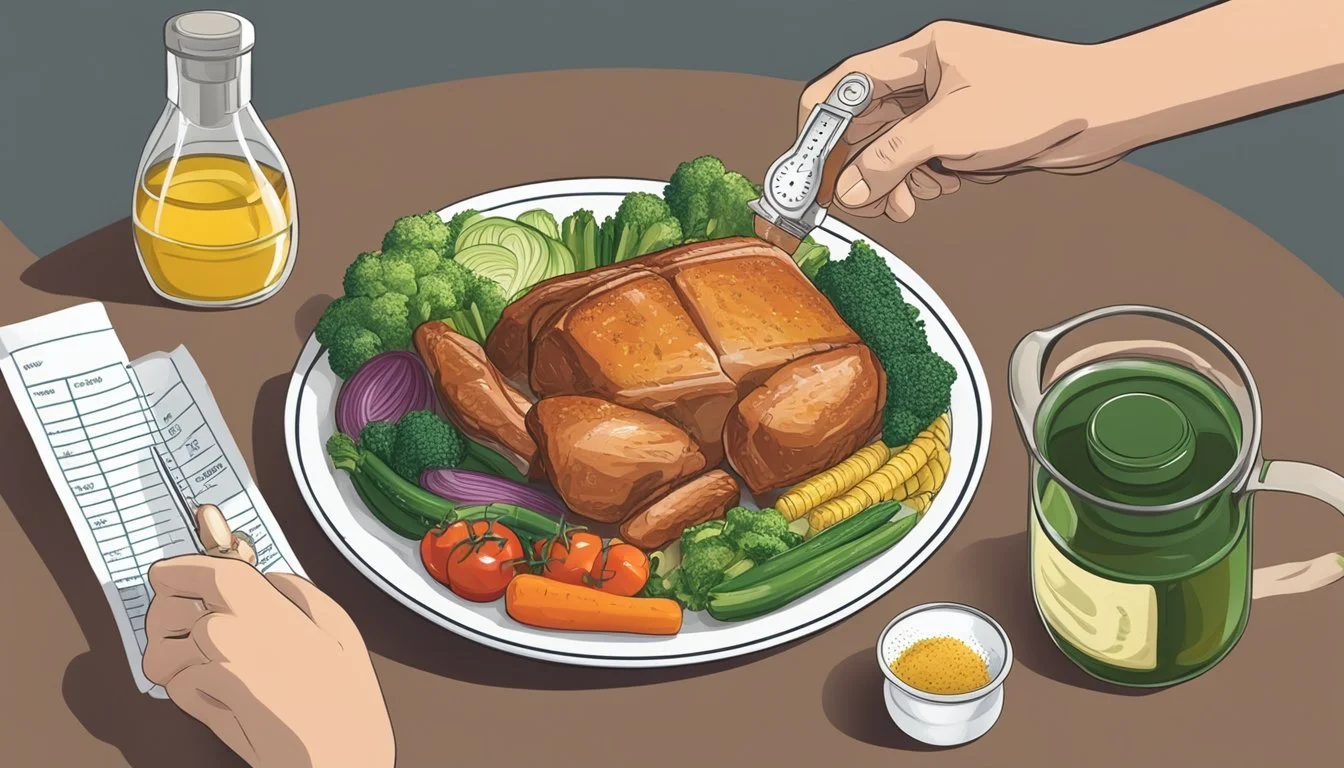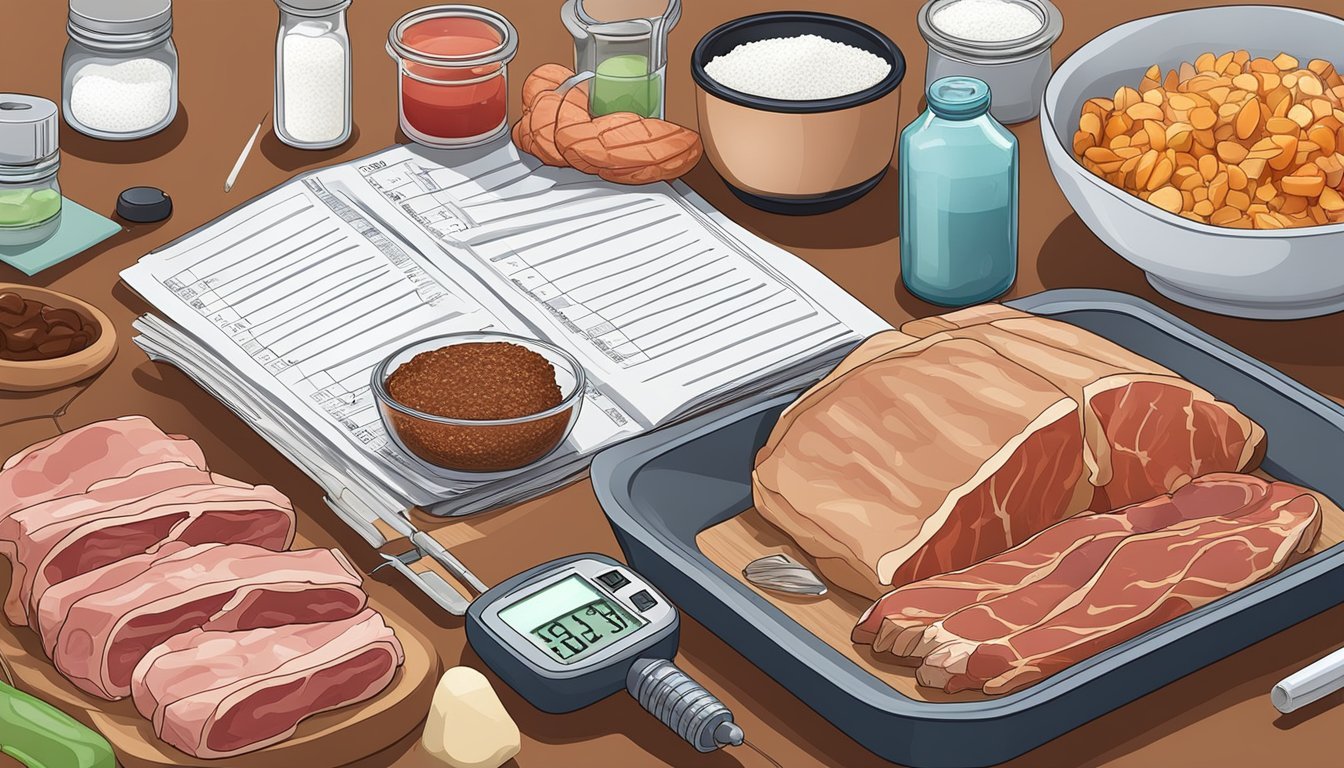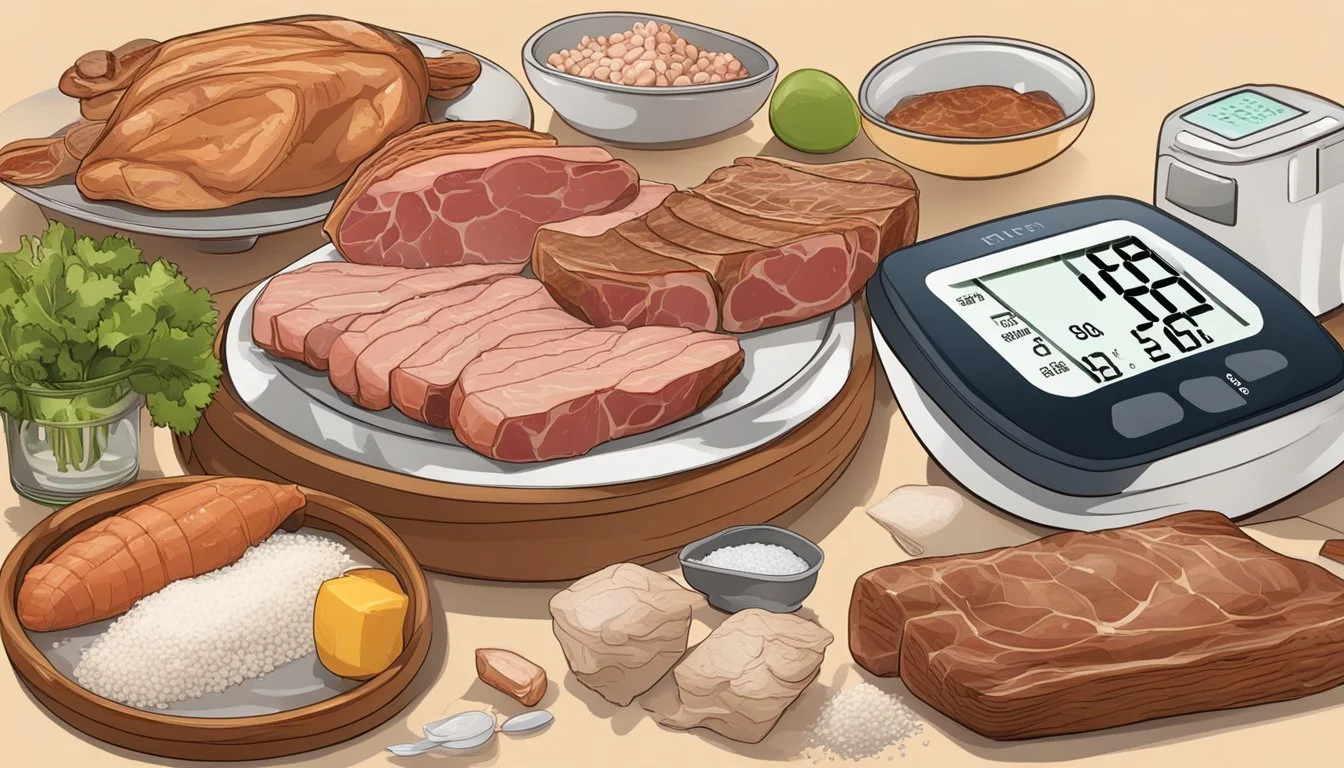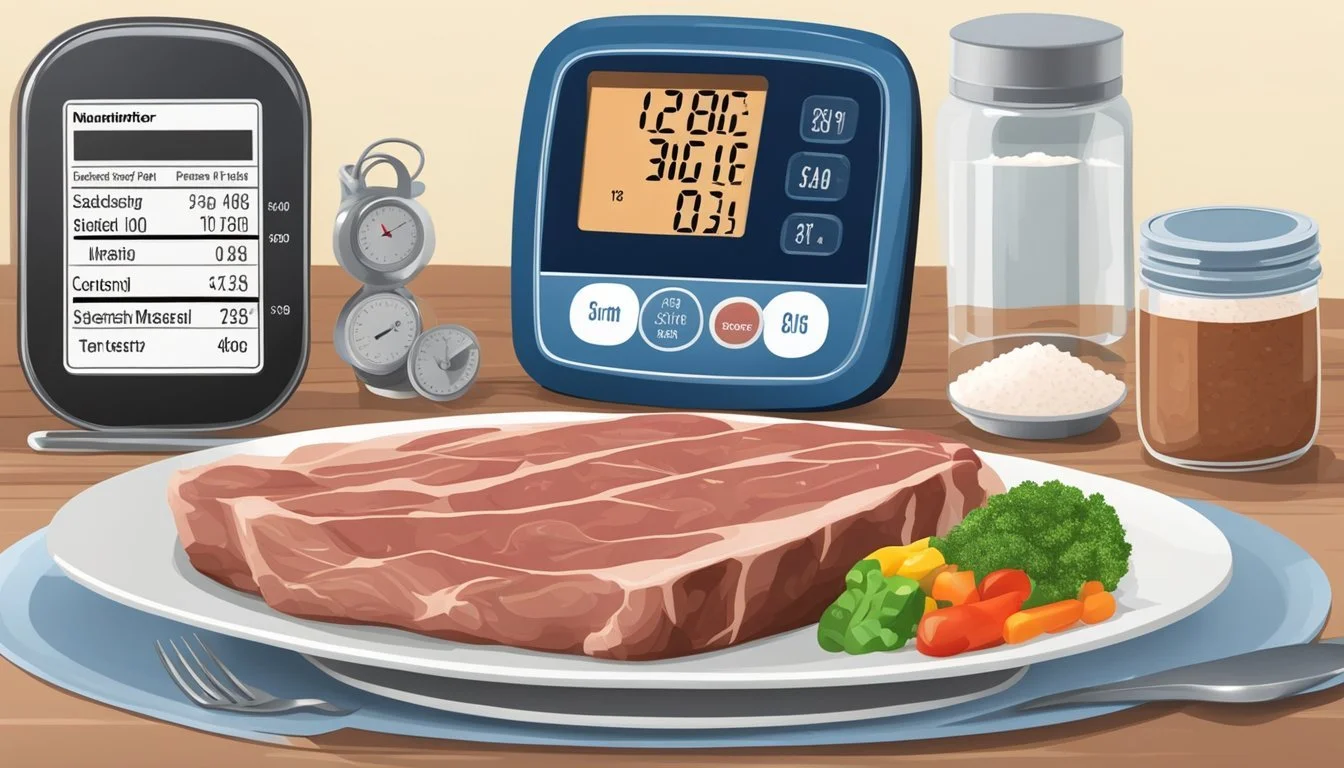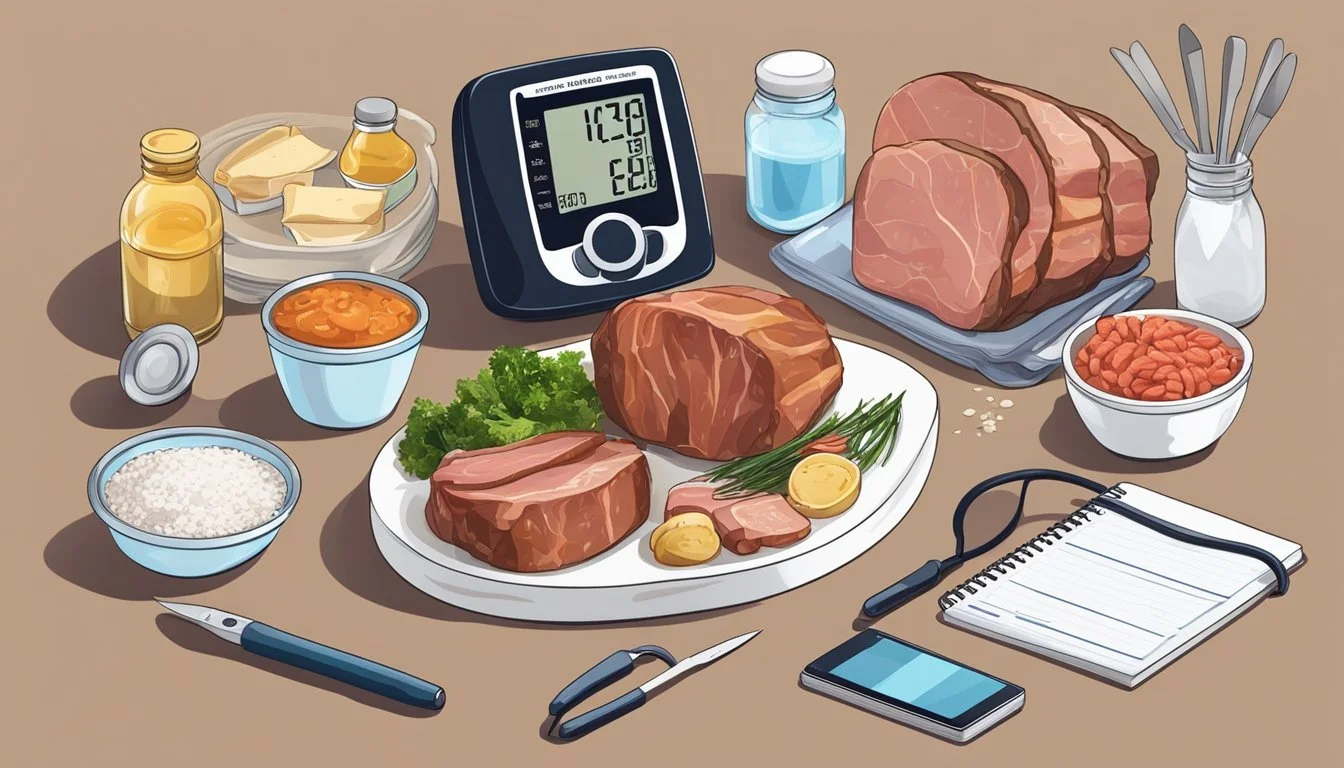The Carnivore Diet for People with Hypertension
Essentials on Salt and Fat Management
The Carnivore Diet has gained attention for its restrictive approach, focusing solely on animal products. In the context of hypertension, individuals consider this diet for potential health benefits, but it raises concerns regarding its impact on blood pressure. The carnivore diet can significantly alter one's intake of fats and sodium, two factors closely monitored by those managing high blood pressure. It is important for individuals with hypertension to understand the implications of adopting such a diet and the necessary steps to take to safeguard their cardiovascular health.
While proponents of the carnivore diet claim it may lead to weight loss or reverse certain health conditions, these potential benefits must be carefully weighed against the need for cardiovascular health maintenance. Since the diet is rich in meats, which may contain higher levels of sodium, especially in processed forms, it is crucial to consider the balance of electrolytes and the overall effect on blood pressure. Likewise, the types of fats consumed on this diet—saturated and unsaturated—can have differing effects on vascular health. An informed approach to the carnivore diet requires a nuanced understanding of these dietary components and their relationship with hypertension.
Understanding Hypertension and the Carnivore Diet
In this section, we examine the relationship between hypertension, a prevalent cardiovascular condition, and the Carnivore Diet, a regimen high in protein and fat but void of carbohydrates.
Defining Hypertension
Hypertension, commonly known as high blood pressure, occurs when the force of the blood against the artery walls is consistently too high. The World Health Organization (WHO) defines hypertension as a condition where the blood pressure in the arteries is persistently elevated. Blood pressure readings comprise two numbers: systolic blood pressure (the higher number, indicating pressure while the heart contracts) and diastolic blood pressure (the lower number, indicating pressure when the heart is at rest). A reading above 130/80 mmHg is generally considered high blood pressure, which increases the risk for heart disease.
Basics of the Carnivore Diet
The Carnivore Diet is centered on the consumption of exclusively animal products. It is characterized by high levels of protein and fat while completely eliminating carbohydrates, which proponents believe mirrors the dietary patterns of ancestral humans. This diet excludes plant-based foods, thereby eliminating sources of dietary sodium and chloride typically found in processed foods. However, since many animal products naturally contain both sodium and fat, monitoring intake is vital for individuals with health concerns such as hypertension.
Hypertension and Carnivore Diet Correlation
Research into the effects of the Carnivore Diet on individuals with hypertension is ongoing. Some sources suggest the diet may aid in resolving or improving high blood pressure due to lower carbohydrate consumption and the consequential potential reduction in overall body fluids and blood pressure. Nonetheless, the heightened intake of saturated fats characteristic of the Carnivore Diet could potentially result in increased LDL cholesterol, a risk factor for heart disease. It is critical for individuals with pre-existing hypertension to consult healthcare professionals before adopting such a significant dietary change to ensure that the balance of blood pressure remains unaffected, or ideally, is improved.
Monitoring Salt Intake on a Carnivore Diet
For individuals on a carnivore diet, especially those with hypertension, regulating salt intake is crucial. Sodium, a key component of salt, plays a vital role in bodily functions but must be balanced to avoid adverse health effects.
Importance of Sodium Balance
Sodium, primarily obtained from salt, is essential for fluid balance and nerve function. However, the American Heart Association recommends no more than 2,300 milligrams a day, moving toward an ideal limit of 1,500 mg per day for most adults—especially for those with hypertension. In the context of a carnivore diet, where processed foods are absent, and whole meats are prevalent, monitoring sodium becomes significant as it can still be present in natural meats and any added salt.
Sources of Sodium in the Carnivore Diet
The carnivore diet mainly consists of meat and animal products, which naturally contain sodium. For example:
Red meats: approximately 55-65 mg of sodium per 3 oz serving.
Organ meats: higher in sodium, liver can contain up to 70 mg per 3 oz.
Seafood: varies widely, salmon has roughly 50-60 mg per 3 oz.
These natural sources can contribute to the daily sodium intake without the addition of extra salt. However, added salt during cooking or at the table can significantly increase sodium consumption.
Managing Sodium Consumption
Individuals should track sodium intake carefully, which may involve:
Choosing unsalted butter and avoiding adding salt during cooking.
Reading labels on bone broth or other permitted seasonings, if used.
Considering salt substitutes especially designed for those with hypertension, provided they do not contain ingredients prohibited in the carnivore diet.
Monitoring effects on blood pressure is also essential. The World Health Organization recognizes the link between high salt intake and increased blood pressure. Consequently, individuals on a carnivore diet should regularly measure their blood pressure as part of managing sodium consumption.
Managing Fat Intake
In the context of the Carnivore Diet for individuals with hypertension, managing fat intake is crucial. The diet's focus on meat means a careful approach to selecting and balancing different types of fats is necessary to support heart health and maintain blood pressure levels.
Types of Fats in Meats
Meats contain a variety of fats, including saturated, monounsaturated, and polyunsaturated fats. The ratio of these fats can differ greatly depending on the type of meat. For example, lean cuts of meat tend to have lower overall fat content, whereas fatty meat typically has a higher proportion of saturated fat. Fish, particularly fatty fish like salmon and mackerel, are rich in beneficial omega-3 fatty acids, which are a form of polyunsaturated fats.
Saturated Fat and Heart Health
Saturated fat has been associated with an increased risk of heart disease when consumed in excess. Meats, especially red and processed meats, are significant sources of saturated fat. Current dietary guidelines suggest that for heart health, saturated fat intake should be limited to less than 10% of total daily calories. Individuals focusing on a carnivore diet for managing hypertension should therefore select meats lower in saturated fats and consider their overall saturated fat consumption.
Balancing Fat Intake for Hypertension
Balancing fat intake is essential for individuals with hypertension. Consuming high-fat meats can increase overall fat intake, which, if not burned through activity, may contribute to obesity—a risk factor for hypertension. It is advised to include a variety of meats and to be mindful of the cuts chosen. Incorporating lean meats and prioritizing the consumption of fish can help manage fat intake. Additionally, when preparing meat, methods such as grilling or broiling rather than frying can help reduce added fats. Monitoring and adjusting fat intake while on a carnivore diet can help manage blood pressure and support cardiovascular health.
Nutritional Considerations on a Carnivore Diet
When adopting a carnivore diet, individuals with hypertension must pay careful attention to how the diet impacts their salt and fat intake, and ensure they are meeting their nutritional needs while avoiding potential risks.
Protein and Nutrient Density
The carnivore diet provides a high level of protein, essential for maintaining muscle mass and numerous bodily functions. Animal foods are inherently nutrient-dense, offering a rich supply of vitamins, particularly B vitamins, and minerals like zinc and iron. It’s important to select meats from a variety of sources, including organ meats, which have a high concentration of trace minerals.
Nutrient Food Source Vitamin B12 Beef liver Zinc Oysters Iron Red meat Selenium Brazil nuts
Potential Risks and Nutritional Deficiencies
Those on a carnivore diet might encounter nutritional deficiencies due to the absence of plant-based foods. Key nutrients typically lacking include fiber, vitamin C, and antioxidants, which are essential for overall health benefits. Moreover, excessive consumption of red and processed meats is often associated with an increased risk of certain health conditions, stressing the importance of monitoring protein and fat quality. High intake of preserved meats can also contribute to elevated salt levels, a concern for individuals with hypertension.
Nutrient Common Deficiency Source Role Fiber Plant-based foods Digestion Vitamin C Fruits and vegetables Immune function, skin health Antioxidants Plant-based foods Counteracting oxidative stress
Counteracting Inflammation and Oxidative Stress
Inflammation and oxidative stress can be exacerbated by diets rich in saturated fats and low in fruits and vegetables, which traditionally have anti-inflammatory properties. Those with hypertension should consider the fatty acid composition of the meats they consume and prioritize sources of omega-3s, such as fish, to support cardiovascular health. The inclusion of foods high in beneficial fats like salmon may help mitigate inflammation. Additionally, ensuring adequate intake of foods like eggs can provide nutrients such as choline, which is anti-inflammatory.
Beneficial Nutrients, Their Food Sources, and Potential Benefits
Omega-3 Fatty Acids
Food Source: Salmon, Fish
Potential Benefit: Reduce inflammation and support heart health
Choline
Food Source: Eggs
Potential Benefit: Supports brain health and reduces inflammation
Lifestyle and Dietary Adjustments
When embarking on the carnivore diet, especially for individuals with hypertension, the importance of lifestyle and dietary adjustments cannot be understated. It is crucial to accompany the diet with regular physical activity, adequate hydration, and tailored adjustments for managing health conditions to support overall health and well-being.
Incorporating Physical Activity
Physical activities play a significant role in managing hypertension and overall health. Regular aerobic and resistance exercises, which involve large muscle groups, are particularly beneficial. For individuals with hypertension, they are encouraged to engage in:
Aerobic exercises: such as walking, jogging, cycling, or swimming for at least 150 minutes per week.
Resistance training: including weight lifting or body-weight exercises, at least two days per week.
Hydration and the Role of Water
Hydration is a critical component of a healthy lifestyle. Water aids in the proper functioning of bodily processes and can help manage blood pressure. Individuals should aim for:
Adequate water intake: around 2-3 liters per day, although needs may vary based on activity levels and health conditions.
Adjustments for Managing Health Conditions
People with health conditions like diabetes, type 2 diabetes, obesity, or those at risk of developing insulin resistance benefit from specific dietary adjustments. For those on a carnivore diet, it is important to:
Monitor salt intake: High salt intake can exacerbate hypertension, so opt for fresh, unprocessed meats with minimal added salt.
Choose lean meats: to manage saturated fat intake, which can be a concern in the context of weight loss and cardiovascular health.
Maintain a balance of omega-3 and omega-6 fatty acids: by including a variety of meats, such as fish, in the diet for their anti-inflammatory effects.
Seek medical guidance regularly to monitor the impact on existing health conditions and potentially achieve remission of metabolic disorders through a well-managed diet and lifestyle changes.
Anecdotal Evidence and Clinical Research
Investigating the carnivore diet requires examining historical anecdotes alongside contemporary clinical research, especially concerning individuals with hypertension and their management of salt and fat intake.
Historical Perspectives on Carnivory
Vilhjalmur Stefansson, an early 20th-century Arctic explorer, provided anecdotal evidence of a meat-centric diet through his experiences with Inuit populations. They subsisted almost exclusively on animal products and appeared to maintain good health without many of the chronic diseases prevalent in western societies. Stefansson's reports suggest that human nutritional needs might be met by animal-based diets alone.
Clinical discussions, such as those by Dr. James DiNicolantonio, advise caution when applying historic carnivorous diets to modern-day settings, particularly due to differences in lifestyle and food processing. For individuals with hypertension, a healthcare provider or registered dietitian should evaluate the suitability of such diets.
Contemporary Research and Findings
Recent research offers a more empirical look at the carnivore diet. A meta-analysis of studies concerning low-carbohydrate, high-protein diets provides some support for their use. However, contemporary studies have not yet provided consistent evidence for or against the adoption of a carnivore diet by people with hypertension, particularly regarding long-term outcomes.
Randomized controlled trials (RCTs), considered the gold standard for clinical studies, are still few and far between in this diet's context. While some experts argue that anecdotal reports from adults on carnivore diets indicate few adverse effects and even some benefits, healthcare professionals stress the significance of supervision and regular monitoring of health markers, particularly sodium and saturated fat intake, when considering such a dietary approach.
The Carnivore Diet and Other Health Considerations
Adopting a carnivore diet can have implications beyond general health, specifically affecting mental well-being, skin, digestion, and long-term health outcomes. Individuals with hypertension should pay special attention to these factors, considering potential nutrient imbalances and conflicting dietary recommendations.
Impact on Mental Health
Research suggests that mental health may be influenced by diet. The carnivore diet, high in animal products, has been anecdotally linked to improvements in mood and reductions in symptoms of anxiety and depression. However, individuals taking medications for mental health should consult healthcare providers due to potential dietary interactions.
Effects on Skin and Digestion
The skin might reflect dietary changes. With the carnivore diet, some experience improvements in conditions like acne, which could be related to eliminating sugar and processed foods. On the other hand, a lack of fiber could lead to constipation, and conditions like leaky gut might not improve without specific fiber types found in plants. Digestive disorders, such as celiac disease or Crohn’s, may respond differently to a carnivore diet; careful monitoring is essential.
Long-Term Health Prospects
Over the long term, adherents to the diet should consider potential risks such as nutrient deficiencies and an increased risk of heart disease, given the diet's high saturated fat content. Adapting the diet with leaner meats and monitoring cholesterol levels could be wise for those with or at risk for heart conditions. Regular health screenings are advised to track any changes and adjust food choices accordingly.
Carnivore Diet Success Stories and Debates
The carnivore diet has generated significant attention for its potential benefits and the controversies surrounding its health implications. This section examines both personal success stories of individuals and the spectrum of expert opinions in the health community.
Personal Success Narratives
Individuals who undertake the carnivore diet often share compelling tales of weight loss and improved health markers. With a focus on consuming only animal products, some report success in shedding significant weight and managing autoimmune conditions. For instance, a dieter may recount the loss of 80 pounds and the alleviation of chronic health issues post-diet adoption. These narratives frequently highlight the diet's role in reducing symptoms of autoimmune diseases, with anecdotes of improved vitality and fewer flare-ups.
Weight Loss: Brian Nowicki reportedly lost 80lbs.
Autoimmune Improvement: Some dieters report reduced symptoms.
Health Expert Debates and Opinions
The carnivore diet remains a source of debate among health experts. A registered dietitian might argue the diet's restrictiveness could pose long-term health risks, given its exclusion of plant-based nutrients. Regarding hypertension, for example, concerns arise around the diet's typically high salt and saturated fat content, which could potentially exacerbate blood pressure issues. Alternatively, proponents might emphasize the lack of carbohydrates and potential benefits such as blood sugar control and mental clarity.
Expert Concerns:
Restrictive nature
Elevated salt and saturated fat intake
Proposed Benefits:
Blood sugar control
Enhanced mental clarity
Choosing the Right Types of Animal Products
When adopting a carnivore diet for managing hypertension, it is vital to select animal products that contribute to overall health while keeping salt and fat intake in check.
Selecting Meats for Optimal Health
Choosing the right meats involves focusing on lean cuts with minimal processing to reduce salt intake, which is crucial for individuals with hypertension. Grass-fed beef and lean cuts of pork and lamb contain lower levels of saturated fat and are more beneficial for heart health than their fattier counterparts. Processed meats like bacon and sausage should be consumed sparingly due to their high sodium content.
Preferred Lean Meats:
Beef: sirloin, tenderloin
Pork: loin chops, tenderloin
Lamb: leg, loin
The Role of Organ Meats and Seafood
Organ meats such as liver and kidneys are rich in essential nutrients like iron, vitamin A, and vitamin B12. They are also lower in fat compared to muscle meats, making them a valuable addition to a diet for hypertension. Seafood and fish offer heart-healthy omega-3 fatty acids, and selecting lean fish such as cod or bass can be beneficial for regulating blood pressure. Fatty fish like salmon provide essential fats but should be eaten in moderation.
Nutrient-Dense Organ Meats:
Chicken kidneys
Heart-Healthy Seafood:
Salmon (in moderation)
Cod
Shrimp
Other Animal Products and Variants
Including a variety of animal products can ensure an adequate intake of different nutrients. Eggs are a versatile option, providing high-quality protein and essential vitamins while still being low in saturated fat, especially when the whites are utilized more than the yolks. For those with hypertension conscious about dairy intake, choosing low-sodium cheese and milk alternatives can help in managing salt consumption.
Diverse Animal Products:
Eggs: particularly egg whites
Dairy: low-sodium cheese, unsweetened yogurt
Frequently Asked Questions
This section provides concise responses to common queries regarding the Carnivore Diet, with a focus on those who have hypertension. Here, we address nutritional concerns and general inquiries about maintaining one's health on this diet.
Addressing Common Concerns
Can I consume salt on the Carnivore Diet if I have hypertension? Individuals with hypertension should monitor their salt intake carefully. Salt is permissible on the Carnivore Diet, but it's crucial to be mindful of the amounts, as excessive salt can exacerbate hypertension.
Is it necessary to eliminate all carbohydrates, including fruits and vegetables, on a Carnivore Diet? Yes, the Carnivore Diet eliminates all plant-based foods, including fruits, vegetables, grains, nuts, and seeds. Instead, it emphasizes consumption of animal products only.
Nutritional FAQs
How can I ensure I get enough potassium on a diet devoid of fruits and vegetables? Animal products like certain meats and fish are good sources of potassium. Individuals on the Carnivore Diet should focus on these to meet their potassium needs.
Example sources of potassium in animal products:
Beef
Salmon
Do dietary guidelines for Americans support the Carnivore Diet? The Dietary Guidelines for Americans recommend a balanced diet that includes fruits, vegetables, grains, and a variety of protein sources. The Carnivore Diet does not align with these guidelines, as it excludes most recommended food groups.
Without whole grains, fruits, and vegetables, how does the Carnivore Diet impact bowel movements ? A lack of dietary fiber from fruits, vegetables, and whole grains may alter bowel movements. Some individuals may experience constipation, while others report that their body adjusts over time.
Can those following a keto or low-carb diet transition easily to the Carnivore Diet? Individuals already on keto or low-carb diets may find it easier to transition to the Carnivore Diet, as both regimens restrict carbohydrates. However, the complete elimination of plant-based foods in the Carnivore Diet is a significant difference.
Carnivore Diet Meal Planning and Recipes
For individuals with hypertension embarking on the carnivore diet, they should prioritize meal planning that manages salt and fat intake effectively. They must carefully select animal-based foods that contribute to overall health while aligning with dietary goals.
Monday:
Breakfast: 3 eggs cooked in unsalted butter
Lunch: 8oz grilled steak with no added salt
Dinner: Patty of ground beef with a side of homemade, unsalted bone broth
Tuesday:
Breakfast: Slices of uncured ham with 2 eggs
Lunch: 8oz baked chicken breast, seasoned with herbs
Dinner: Pork chops (What wine goes well with pork chops?) with a side of unsalted bone broth
Select Recipes:
Baked Chicken Breast: Season the chicken with herbs and bake until the internal temperature reaches 165°F.
Unsalted Bone Broth: Simmer bones in water with a bay leaf, avoiding added salt.
Beef Patty: Shape ground beef into a patty and cook to desired doneness.
They should strive to use fresh, unprocessed meats whenever possible to limit sodium content inherently present in processed options. Swapping out added salts with herbs can enhance flavor without elevating blood pressure. Individuals can create rich, simple broths as a sodium-conscious way to include nutrients and hydration, which are essential when adapting to a zero-carb diet.
They should listen closely to their body’s reactions and be prepared to adjust meal plans and recipes as needed, maintaining a keen eye on blood pressure levels. It's advisable to consult with a healthcare provider before making any significant dietary changes, especially for those with hypertension.
Conclusion
Individuals with hypertension undertaking the Carnivore Diet should be vigilant about their salt and fat intake. High consumption of animal products may lead to an increased intake of saturated fats and sodium, which can exacerbate high blood pressure.
Salt Intake: It is essential for hypertensive individuals to monitor their sodium consumption, as high salt intake is linked to elevated blood pressure. The diet should ensure a balance to avoid potential negative impacts on blood pressure.
Saturated Fat: Similarly, the high levels of saturated fat typical in animal products can contribute to cardiovascular issues. Individuals should be aware of the types of fats they are consuming and prioritize leaner meats if necessary.
Regular Monitoring: Regular monitoring of blood pressure is advised to observe any changes that may occur due to dietary adjustments.
Consult Healthcare Providers: Engaging with healthcare providers can assist in tailoring the dietary approach to individual health needs and mitigate risks associated with hypertension.
Diversified Approach: A diversified approach may be recommended, with emphasis on including nutrients that may be lacking in the Carnivore Diet and considering overall caloric intake.
In essence, individuals should proceed cautiously with the Carnivore Diet if they have hypertension. Maintaining an awareness of salt and fat intake and regular health check-ups are prudent steps to ensure well-being while following this diet.



